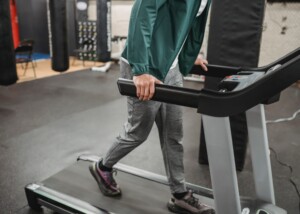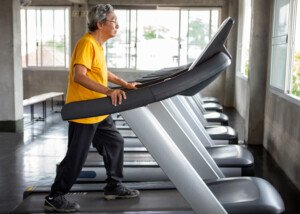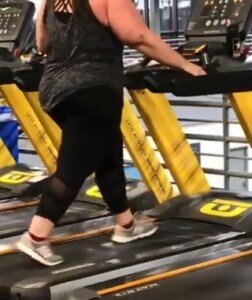
If you’re very plus size and trying to achieve goals by walking on a treadmill, did you know that holding on will interfere with your goals?
Holding onto the treadmill drastically reduces the workload.
When I was a trainer I forbad my very plus size, as well as more moderately overweight, medium and even thin clients from engaging in this fruitless practice.
Even if you’re not trying to lose weight at this time, you need to keep reading.
Better fitness (and weight loss) result from imposing a demand on your body that’s greater than its baseline activity (activity it’s used to).
Holding onto a treadmill puts you at below baseline because in day to day living, you don’t hold onto anything when walking from Point A to Point B.
The top three reasons for holding onto a treadmill are:
1) Fear of falling off, 2) Can’t keep up with the tread and 3) Everone else does it.
Well of course there’s a fear of falling off and inability to keep up with the tread — because people who hold on sometimes have the tread going too fast for their capabilities.
In other cases, the fear is psychological and has no physical validation such as a neurological balance disorder.
They Didn’t Fall Off
I’ve witnessed this tons of times, when people (including very heavy) take their hands off the machine — after I urge them to — and they remain upright and continue walking — no falling, not even any teetering.
Plus, people often see what everyone else is doing, then copy them, often without realizing this.
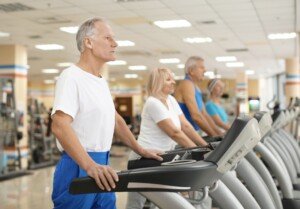
Popularity doesn’t equal effectiveness. Shutterstock/Africa Studio
The rails and bar DO have a legitimate purpose, such as to steady yourself while you’re turning around to look at something, sip water, wipe sweat off your face or adjust the settings.
But clinging to the bar or rails throughout your entire walking session defeats the purpose.
Even if you’re very large and feel out of shape, holding fast to a treadmill beyond what’s momentarily necessary will interfere with your goals.
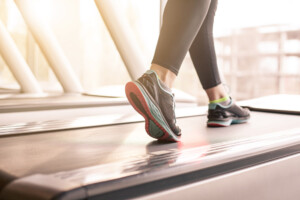
Holding onto a treadmill even alters the foot strike. Hands-free ensures correct foot strike. Freepik.com, master1305
“At Least I’m not at Home Sitting on a Couch.”
I’ve heard this more than once. You’ll be sitting on your sofa sooner or later. It’s in your house. It’s there to be sat on. Stop pointing this out.
It’s also a very low standard of reference. If you must use this very low standard to justify holding onto something while you’re walking, then this should be a wakeup call — a call to walk ABOVE baseline to get the results you want.
“Treadmill exercisers tend to hold onto the rails, which alters the gait and restricts natural movement,” says Barbara Bergin, MD, board certified orthopedic surgeon at and co-founder of Texas Orthopedics, Sports & Rehabilitation Associates.
“This can result in a variety of musculoskeletal issues.
“Use the rails intermittently at most, just to maintain your balance.
“Try to just touch the rail, as opposed to grabbing it and hanging on for dear life.”
People with “Perfect” Bodies Who Hold onto the Treadmill
Those individuals are just as wrong for holding onto the treadmill as someone who is 100 pounds over their ideal body weight.
What about an incline?
The hands-off rule should also apply to inclines.
If you cannot walk an incline without holding on, this means one or both of two things:
- The speed is too fast.
- The incline is too high.
To walk with your hands off, you must choose appropriate settings.
“People using the treadmill tend to use it uphill a lot more than they might ordinarily walk or run uphill on the street or on a trail,” says Dr. Bergin.
“Don’t walk up hill continuously. It’s rare for natural terrain to continuously stay uphill.
“We must eventually come down, so when naturally walking or running, we would go up and down, and spend some time on the flat surface.”
If you believe that holding on doesn’t make any difference when using an incline, test your theory by walking outside, up an inclined path, at the same speed you use with a treadmill.
You’ll be panting soon into it, and it’ll feel a lot harder because you’re not holding onto anything for support.
Easy Correction
Once you realize these facts, you should not despair, because the correction is simple:
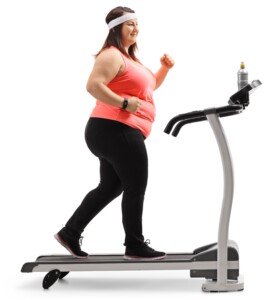
Shutterstock/Ljupco Smokovski
From this point forward, even if you’re significantly plus size, aim to keep your hands off the treadmill — save for those momentary balance checks.
Move your arms naturally as you would if walking outside.
Hold on only when you need to (e.g., drinking, adjusting settings).

Dr. Bergin is a general orthopedist, surgically and conservatively treating all manner of bone and joint conditions. She enjoys educating patients so they can emerge stronger than they were before their orthopedic injury or surgery.
 Lorra Garrick is a former personal trainer certified through the American Council on Exercise. At Bally Total Fitness she trained women and men of all ages for fat loss, muscle building, fitness and improved health.
Lorra Garrick is a former personal trainer certified through the American Council on Exercise. At Bally Total Fitness she trained women and men of all ages for fat loss, muscle building, fitness and improved health.

